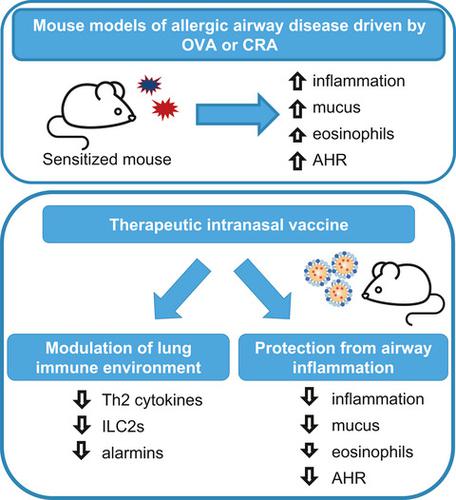当前位置:
X-MOL 学术
›
Clin. Exp. Allergy
›
论文详情
Our official English website, www.x-mol.net, welcomes your feedback! (Note: you will need to create a separate account there.)
Intranasal delivery of allergen in a nanoemulsion adjuvant inhibits allergen-specific reactions in mouse models of allergic airway disease
Clinical & Experimental Allergy ( IF 6.1 ) Pub Date : 2021-05-17 , DOI: 10.1111/cea.13903 James R Baker 1 , Andrew J Rasky 2 , Jeffrey J Landers 1 , Katarzyna W Janczak 1 , Tiffanie D Totten 1 , Nicholas W Lukacs 1, 2 , Jessica J O'Konek 1
Clinical & Experimental Allergy ( IF 6.1 ) Pub Date : 2021-05-17 , DOI: 10.1111/cea.13903 James R Baker 1 , Andrew J Rasky 2 , Jeffrey J Landers 1 , Katarzyna W Janczak 1 , Tiffanie D Totten 1 , Nicholas W Lukacs 1, 2 , Jessica J O'Konek 1
Affiliation

|
Atopic diseases are an increasing problem that involve both immediate hypersensitivity reactions mediated by IgE and unique cellular inflammation. Many forms of specific immunotherapy involve the administration of allergen to suppress allergic immune responses but are focused on IgE-mediated reactions. In contrast, the effect of allergen-specific immunotherapy on allergic inflammation is complex, not entirely consistent and not well understood. We have previously demonstrated the ability of allergen administered in a nanoemulsion (NE) mucosal adjuvant to suppress IgE-mediated allergic responses and protect from allergen challenge in murine food allergy models. This activity was associated with decreases in allergen-specific IL-10 and reductions in allergic cytokines and increases in regulatory T cells.
中文翻译:

在纳米乳佐剂中鼻内递送过敏原抑制过敏性气道疾病小鼠模型中的过敏原特异性反应
特应性疾病是一个日益严重的问题,它涉及由 IgE 介导的即时超敏反应和独特的细胞炎症。许多形式的特异性免疫疗法涉及施用过敏原以抑制过敏性免疫反应,但集中于 IgE 介导的反应。相比之下,过敏原特异性免疫疗法对过敏性炎症的影响是复杂的,并不完全一致,也不是很清楚。我们之前已经证明了在纳米乳剂 (NE) 粘膜佐剂中施用过敏原抑制 IgE 介导的过敏反应并保护小鼠食物过敏模型免受过敏原攻击的能力。这种活性与过敏原特异性 IL-10 的减少和过敏性细胞因子的减少以及调节性 T 细胞的增加有关。
更新日期:2021-05-17
中文翻译:

在纳米乳佐剂中鼻内递送过敏原抑制过敏性气道疾病小鼠模型中的过敏原特异性反应
特应性疾病是一个日益严重的问题,它涉及由 IgE 介导的即时超敏反应和独特的细胞炎症。许多形式的特异性免疫疗法涉及施用过敏原以抑制过敏性免疫反应,但集中于 IgE 介导的反应。相比之下,过敏原特异性免疫疗法对过敏性炎症的影响是复杂的,并不完全一致,也不是很清楚。我们之前已经证明了在纳米乳剂 (NE) 粘膜佐剂中施用过敏原抑制 IgE 介导的过敏反应并保护小鼠食物过敏模型免受过敏原攻击的能力。这种活性与过敏原特异性 IL-10 的减少和过敏性细胞因子的减少以及调节性 T 细胞的增加有关。



























 京公网安备 11010802027423号
京公网安备 11010802027423号